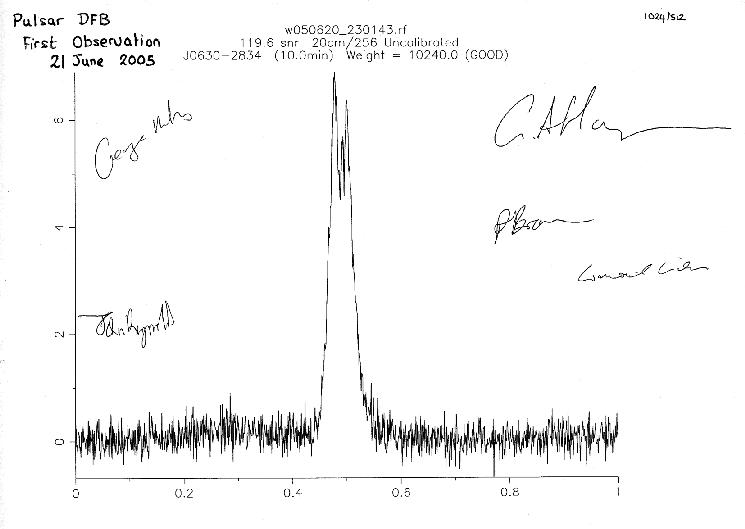Success for the prototype Pulsar Digital Filter Bank!

First light for Pulsar Digital Filter Bank. Image credit: John Sarkissian.
The prototype Pulsar Digital Filter Bank (PDFB) was successfully installed at Parkes on 21 June 2005. The installation went quickly and smoothly, with project scientist, George Hobbs, obtaining pulse profiles with full Stokes parameters on several pulsars on the evening of the same day.
To counter the effects of interstellar dispersion, all pulsar observing systems require a method of dividing the observed bandwidth into narrow channels. Analogue filterbanks, correlation spectrometers and baseband coherent de-dispersion systems have all been employed in the past and each type of system has its own advantages and disadvantages for a particular application. To provide the very wide bandwidths and high time-resolution required for current precision timing and polarization observations, the ATNF is developing a Pulsar Digital Filterbank (PDFB) system based on implementation of a polyphase filter in FPGA processors.
Project engineers Grant Hampson and Andrew Brown are pictured in front of the prototype PDFB system. The prototype has the ability to process 8-bit sampled data with 256 MHz of bandwidth. These data are processed using a Nallatech FPGA hardware development platform. A custom Radix-4 digital filter bank has been developed by the Electronics Group.
The Nallatech board provides the necessary pulsar binning memory which can handle 2048 phase bins, 2048 frequency channels, four products, all with 32-bit resolution. Using this configuration it is possible to observe pulsars with a minimum period of 84 ms. By reducing the number of pulse phase bins or frequency channels it is possible to observe pulsars with millisecond periods.
Many thanks to Warwick Wilson for writing the necessary software to integrate the prototype PDFB system into the telescope software. George Hobbs and Dick Manchester have analysed much of the collected data and in some situations find that the prototype performs significantly better than its predecessor. The prototype is still operational and being used by many pulsar astronomers.
Project engineers Grant Hampson and Andrew Brown. Photo: John Sarkissian
Our first visit to Parkes was very enjoyable it was great for us to observe real pulsars (instead of simulated ones) in a real telescope environment, complete with RFI! Thank you to all of the Parkes staff for making our visit a success.
Since the installation at Parkes our time has been devoted to developing a custom hardware design that meets the user requirements. This hardware will process 1 GHz of bandwidth with 8-bit sampled data (part of CABB upgrade developments). It will process this data using the latest FPGA technology from Xilinx and Quad Data Rate memory from Samsung. A Radix-8 digital filter bank design has been simulated in Matlab/Simulink to process the data. It will be possible to measure 4-ms pulsars using the binning memory configuration discussed previously a 20-fold increase!
Grant Hampson, Andrew Brown, Dick Manchester and George Hobbs
(Grant.Hampson@csiro.au, Andrew.Brown@csiro.au, Dick.Manchester@csiro.au, George.Hobbs@csiro.au)
